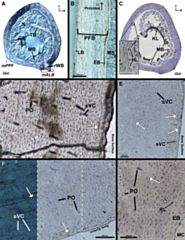Project 4029: C. T. Heck, H. N. Woodward. 2021. Intraskeletal bone growth patterns in the North Island Brown Kiwi ( Apteryx mantelli ): Growth mark discrepancy and implications for extinct taxa. Journal of Anatomy. 239 (5):1075-1095.
Abstract
Osteohistology, the study of bone microstructure, provides an important avenue for assessing extinct and extant vertebrate growth and life history. Cortical vascularity and collagen fibre organization are direct reflections of growth rate, while bone growth marks are indicative of absolute age. However, each skeletal element has its own ontogenetic trajectory and microstructure of certain bones may not be a true representation of whole body growth. Extensive comparative study of modern taxa is required to resolve intraskeletal discrepancies among age, vascularity and tissue organization in extinct vertebrates. Despite their comparative utility, studies of bone microstructure in modern taxa are severely lacking. Here, we add to a growing comparative osteohistological database by describing (1) bone tissue organization, (2) growth mark count, (3) sexually dimorphic bone (e.g. medullary bone) and (4) secondary cortical reconstruction in the bone microstructure of a 14-year-old male and 5-year-old female North Island Brown Kiwi (Apteryx mantelli). Transverse and longitudinal histological ground sections were processed and described for femora, tibiotarsi, tarsometatarsi, humeri, ulnae and radii in both kiwis. Cortical bone can generally be described as parallel-fibered tissue, interrupted by cyclical growth marks, with vascular canals oriented longitudinally within primary and secondary osteons. Tissue morphologically resembling medullary bone is present in the hindlimbs of the female, and coarse compacted cancellous bone (CCCB) is found sporadically in the male and female hindlimbs. Lines of arrested growth (LAGs) are present in all hindlimb bones of both kiwi, but remodelling has obliterated all LAGs in the male ulnae and radii. LAG count varies intraskeletally, but large weight bearing elements such as femora and tibiotarsi have less remodelling and, thus, higher number of LAGs. LAG count did not match absolute age in any skeletal element; a maximum of seven LAGs are present in the male kiwi and a maximum of seven LAGs in the female kiwi. The tissue organization within the forelimbs and hindlimbs is reflective of the protracted growth strategy of the North Island Brown Kiwi and congruent with previous studies of the kiwi. LAGs were highly variable throughout the skeleton of the kiwi and a decoupling of age and LAG deposition is apparent from the male kiwi samples. Excess LAGs in the 5-year-old female kiwi may be a product of hatching, egg laying or captivity. Regardless, LAG count variation in the kiwi stresses the importance of intraskeletal sampling when assessing growth patterns of extinct taxa. An extensive ontogenetic sampling of kiwi is necessary for future investigations of bone growth patterns, CCCB formation, medullary bone and LAG deposition and obliteration in these elusive birds.Read the article »
Article DOI: 10.1111/joa.13503
Project DOI: 10.7934/P4029, http://dx.doi.org/10.7934/P4029
| This project contains |
|---|
Download Project SDD File |
Currently Viewing:
MorphoBank Project 4029
MorphoBank Project 4029
- Creation Date:
09 June 2021 - Publication Date:
04 October 2022
Authors' Institutions ![]()
- Oklahoma State University

